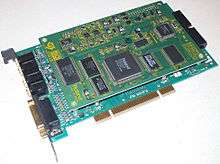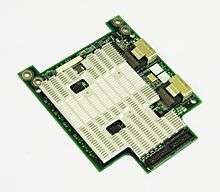Daughterboard


A daughterboard, daughtercard, mezzanine board or piggyback board is a circuit board meant to be an extension or "daughter" of a motherboard (or 'mainboard'), or occasionally of another card. In particular, daughterboards often have plugs, sockets, pins, connectors, or other attachments for other boards, which is what differentiates them from standard expansion boards such as for PCI or ISA, which are usually called expansion cards. In addition, daughterboards usually have only internal connections within a computer or other electronic devices rather than any external ones, and usually access the motherboard directly rather than through a computer bus.
Daughterboards are sometimes used in computers in order to allow for expansion cards to fit on their side (or upright), parallel to the motherboard, usually to maintain a small or slim form factor. In this case they can also be called riser cards, or risers. Daughterboards are also sometimes used to expand the basic functionality of an electronic device, such as when a certain model has features added to it and is released as a new or separate model. Rather than redesign the first model completely, a daughterboard may be added to a special port or connector on the motherboard or mainboard. These usually fit on top of and parallel to the board, separated by spacers or standoffs, and are therefore sometimes called mezzanine cards due to being stacked like the mezzanine of a theatre. Wavetable cards (sample-based synthesis cards) are often mounted on sound cards in this manner.
Some mezzanine card interface standards include the 400 pin FPGA Mezzanine Card (FMC); the 172 pin High Speed Mezzanine Card (HSMC);[1][2] the PCI Mezzanine Card (PMC); XMC mezzanines; the Advanced Mezzanine Card; IndustryPacks (VITA 4), the GreenSpring Computers Mezzanine modules; etc.
Types
- Enhanced Graphics Adapter piggyback board, adds memory beyond 64 KB, up to 256 KB[3]
- Expanded memory piggyback board, adds additional memory to some EMS and EEMS boards[4]
- ADD daughterboard
- RAID daughterboard
- Network interface controller (NIC) daughterboard
- CPU Socket daughterboard
- Bluetooth daughterboard
- Modem daughterboardRC070723650MY
- AD/DA/DIO daughter-card
- Communication daughterboard (CDC)
- Server Management daughterboard (SMDC)
- Serial ATA connector daughterboard
- Robotic daughterboard
- Access control List daughterboard
- Arduino "shield" daughterboards.
See also
- Creative Wave Blaster
- M-Module, an industrial mezzanine standard for modular I/O
- PowerUP accelerators, CPU and memory daughterboard for Amiga systems
- Riser card
References
- ↑ Jens Kröger. "Data Transmission at High Rates via Kapton Flexprints for the Mu3e Experiment". 2014. p. 43 to 44.
- ↑ Altera. "High Speed Mezzanine Card (HSMC) Specification". p. 2-3.
- ↑ Market Looks to EGA as De Facto Standard, InfoWorld, Aug 19, 1985
- ↑ Product Comparison: 16-Bit EMS Memory, InfoWorld, Sep 7, 1987